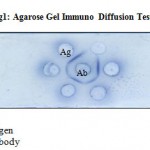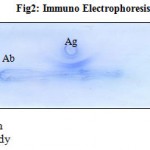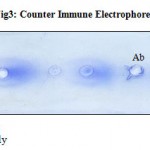How to Cite | Publication History | PlumX Article Matrix
Immunological Studies of Outer Membrane Proteins of E. Coli From Poultry
M. Suresh1, Y. Hari Babu1, S. Venkateshwar2 and M. Narsi Reddy2*
1Department of Veterinary Microbiology, Veterinary College, Bidar - 585 401India.
2Centre for Biotechnology, University College of Technology, Osmania University, Hyderabad - 500 007 India.
Corresponding Author E-mail: mnreddydr@gmail.com
ABSTRACT: The effective control of avian colibacillosis has not been achieved world wide because of involvement of large number of serotypes, failure of whole cell bacterium to induce immuniy towards heterogenous serotypes and high cost of vaccination; moreover the protection offered by vaccine is of short duration. A total of 24 six weeks old commercial layer birds were divided into 3 groups comprising of 8 in each group. The vaccine was prepared using E. coli O6, O20 and O109 serotypes with FICA. Birds in the test group I injected with 0.5ml of vaccine which contains 77 μg OMP by oral route, similarly birds in the test group II injected with 0.5ml of vaccine which contains 77 μg OMP by s/c route. Birds in the control group injected with normal saline only. At 9th week both birds in the control as well as test groups were challenged by i/v route using live E. coli O20 serotype @ 1.5x 108 CFU/bird. However following i/v challenge with O20 strain, OMP vaccinated birds at 21 days post vaccination resulted in death of 7 birds in control group compared to death of 2 birds in T-I the percentage of survivability of birds is 75%.and 1 bird in T-II group the percentage survivability (efficacy) is 88.33. Different immunological tests like AGID, CIE and IE showed the presence of antibodies against OMPs of E.coli from poultry. OMP can be a potential vaccine candidate for the prevention of poultry colibacillosis in field condition.
KEYWORDS: OMP; E.coli; colibacillosis; AGID; IE; CIE
Download this article as:| Copy the following to cite this article: Suresh M, Babu Y. H, Venkateshwar S, Reddy M. N. AImmunological Studies of Outer Membrane Proteins of E. Coli From Poultry. Biosci Biotechnol Res Asia 2009;6(1) |
| Copy the following to cite this URL: Suresh M, Babu Y. H, Venkateshwar S, Reddy M. N. AImmunological Studies of Outer Membrane Proteins of E. Coli From Poultry. Biosci Biotechnol Res Asia 2009;6(1). Available from: https://www.biotech-asia.org/?p=8201 |
Introduction
Outer membrane proteins are the proteins exists in large quantities in the outer membrane of pathogenic Gram negative bacteria and are often implicated as virulence factors. They are surface exposed and therefore suitable for vaccine development. Outer membrane proteins are indispensable components of bacterial cells and participate in relevant functions of the microorganisms. Changes in the outer membrane protein composition might alter antibiotic sensitivity and pathogenicity.
The outer membrane proteins of avian E.coli play significant role in the pathogenesis of avian colibacillosis and have been identified as potent immunogen. The immunogenicity of selected outer membrane proteins of E.coli was demonstrated in mice and chickens (Chen et al., 2005).
Material and Methods
A total of 24 six weeks old commercial layer birds were divided into 3 groups comprising of 8 in each group. They were housed in cage system of rearing under optimal managemental conditions and provided with antibiotic free feed and water. The vaccine was prepared using E. coli O6, O20 and O109 serotypes with FICA. The vaccine was subjected to sterility test to rule out untoward effects and tissue reactions at the site of injection.
Birds in the test group I injected with 0.5ml of vaccine which contains 77 µg OMP by oral route, similarly birds in the test group II injected with 0.5ml of vaccine which contains 77 µg OMP by s/c route (Panigrahy et al. 1984). Birds in the control group injected with normal saline only. After 21 days of vaccination, serum collected and subjected for different immunological tests.
At 9th week both birds in the control as well as test groups were challenged by i/v route using live E. coli O20 serotype @ 1.5x 108 CFU/bird.
The serum samples were collected all the birds vaccinated at 21 days after the vaccination and before the challenge used for different immunological tests like AGID, IE, CIE.
Results and Discussion
A total of seven E. coli isolates were recovered from fifteen processed samples that were collected from different organs like intestine (two/ four), heart blood (one / four), liver (two/four) and spleen (one/three) of birds suspected for colibacillosis (46.66 %).
The results indicated that the serotype O20 and O109 were most prevalent (two each), O6 and O60 (one each). One isolate was rough strain, which was untypable.
A total of 24 six weeks old commercial layer birds were divided into 3 groups comprising of 8 in each group. They were housed in cage system of rearing under optimal manage mental conditions and provided with antibiotic free feed and water.
The vaccine was prepared using E. coli O6, O20 and O109 serotypes with FICA. Number of workers used FICA as adjuvant for vaccination (Deb and Harry 1978, Confer et al. 1995). Confer et al. (1995) vaccinated beef cattle using OMP along with FICA.
After 21 days of vaccination, serum collected and subjected for different immunological tests like AGID, IE, CIE. Heller, 1975 reported that antibodies could be detected as early as 4 days after first injection reaching a peak at the 20th day. Thickness of the band indicates the presence of antibody. The results are furnished below,
 |
Figure 1: Agarose Gel Immuno Diffusion Test (AGID).
|
 |
Figure 2: Immuno Electrophoresis (IE).
|
 |
Figure 3: Counter Immune Electrophoresis (CIE).
|
At 9th week both birds in the control as well as test groups were challenged by live E. coli O20 serotype @ 1.5x 108 CFU/bird by i/v route. Harry (1964) reported that losses from coliseptisemia in the field are normally high at 6-9 week of age and find that i/v route was an effective route for challenge study.
However following i/v challenge with O20 strain, OMP vaccinated birds at 21 days post vaccination resulted in death of 7 birds in control group compared to death of 2 birds in T-I and 1 bird in T-II groups.
A total of two birds died out of 8 birds in the group I during the challenge study. The percentage of survivability of birds is 75%. Our findings are in accordance with Deb and Harry, (1976) where 20 vaccinated birds using E. coli alum precipitated vaccine by s/c route. They showed that 5 birds died of 20 birds.
Similarly in the group II only one bird died out of 8 birds vaccinated subcutaneously. The percentage survivability (efficacy) is 88.33. The results are in accordance with Deb and Harry (1978) carried out vaccination to 22 birds by using E. coli O2 oil adjuvanted vaccine. A total of 4 birds died of 22 birds accounting for 83 % efficacy of the vaccine.
In the control group only one bird died out of 8 birds in which birds received only normal saline. The % mortality in the control group is 87.5 %.
Table1: Mortality pattern of vaccinates and unvaccinates after challenge.
| Vaccinated | Un vaccinated | ||||||||
| Test group-I
Oral |
Test group-II
S/C |
Control group | |||||||
| No. challenged | No. died | % mortality | No. challenged | No. died | %
mortality |
No. challenged | No. died | % mortality | |
| challenge | 8 | 2 | 25 | 8 | 1 | 16.67 | 8 | 7 | 87.5 |
In the protective study conducted by Zadeh et al (2004), showed a very good level of protection with three dead out of 15, while the saline injected controls showed 12 dead out of 15 i.e. the % efficacy of vaccine was found to be 80%.
Future Prospectus
With the present preliminary study there is a need for further detailed study towards the use of OMP as vaccine in poultry relating to its dosage, different routes, level of protection and duration of immunity.
References
- CHEN, H.Y., HUANG, Q.Y. AND CHEN, G.Z., 2005, Immunogenicity of the OMP of poultry sourced E. coli O2and O78 their antibiotic resistance and their fusion strains. Journal of south China agricultural university. 26(1):106-109.
- CONFER A.W., Mc CRAW, R.D., DURHAM, J.M., MORTON, R.J. AND PANCEIRA, R.J., 1995, Serum antibody responses of cattle to iron regulated OMPs of P.haemolytica A1. Vet. Immunology. Immunopathology. 47(1/2):101-110.
- DEB, J. R., AND HARRY, E. G., 1976, Laboratory trials with inactivated vaccines against Escherichia coli (O78:K80) infection in fowls. Res. Vet. Sci., 20:
131-138. - DEB, J. R., AND HARRY, E. G., 1978, Laboratory trials with inactivated vaccines against Escherichia coli (O2:K1) infection in fowls. Res. Vet. Sci., 24:
308-313. - HARRY, E.G., 1964, A study of 119 outbreak of coliseptecemia in broiler flocks. Vet. Rec., 76: 443-449.
- HELLER, L. D., 1975, The immune response of hens to multiple Escherichia coli
- injections and transfer of immunoglobulins to the eggs and hatched chick. Res. Vet. Sci., 18:117-120.
- PANIGRAHY, B., GYIMAH, J. E., HALL, C. F. AND WIILIAMS, J. D., 1984, Immunogenic potency of an oil-emulsified Escherichia coli bacterin. Avian Dis., 28(2):475-481.
- ZADEH, F.V., ESMIALY, F. AND YAZDI, M.K.S., 2004, Protective immune responses induced in chickens by outer membrane proteins extracted from different trains of Escherichia coli. Iranian Journal of Allergy, Asthma and Immunology. 3(3): 133-137.

This work is licensed under a Creative Commons Attribution 4.0 International License.





